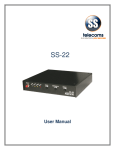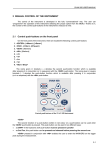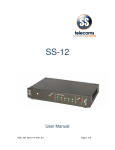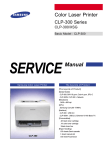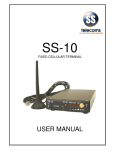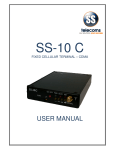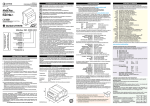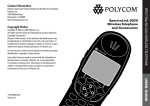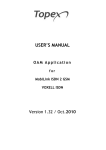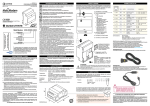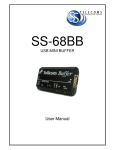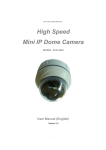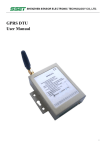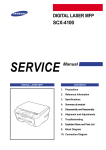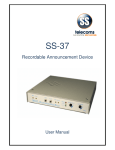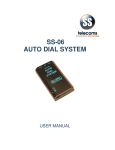Download SS-15 BRI Multi SIM
Transcript
SS-15 BRI MULTI SIM (ISDN 2 GSM) USER MANUAL SS-15 BRI MULTI SIM (ISDN 2 GSM) USER MANUAL Revision History: Revision 01 Revision 02 Revision 03 New document LED`s status update Added Multi Sim Content 14 September 2009 02 December 2009 10 March 2010 CONTENTS 1. INTRODUCTION 3 2. WHAT IS SS-15 BRI MULTI SIM (ISDN 2 GSM)? 3 3. PACKAGE CONTENT 4 4. 4.1 4.2 4.3 4.4 4.5 4.6 4.7 4.8 4.9 4.10 4.11 INSTALLATION IDENTIFYING THE CONNECTORS CONFIGURING THE SIM CARDS INSERTING THE SIM CARDS CONNECTING THE CABLES INSTALLING THE EXTERNAL ANTENNAS JUMPER SETTINGS POWER UP SS-15 BRI (ISDN 2 GSM) LED INDICATORS PINOUT FOR THE CONNECTORS MOUNTING THE SS-15 BRI (ISDN 2 GSM) EQUIPMENT INSTALLING THE PROGRAMMING TOOL 5 5 5 6 7 7 9 10 11 12 14 14 5. 5.1 5.2 OPERATION AND MODES OF CONNECTION ROUTING FOR LEAST COSTS MODES OF CONNECTION 15 15 16 6. OPERATING ENVIRONMENT 22 7. BENEFITS 23 6. CONTACT DETAILS 24 DOC. NO: SS-15BRI-14 (REV. 01) Page 2 of 24 SS-15 BRI MULTI SIM (ISDN 2 GSM) USER MANUAL 1. INTRODUCTION By purchasing an SS-15 BRI Multi SIM you have opted for: cutting down the costs of your cellular calls; ISDN to GSM interface with LCR capabilities; excellent audio quality; availability of SMS functions; perfect compatibility to ISDN private branch exchanges (PBX); routing functions assured even when used as standalone unit; full compatibility with GSM 900/1800 or 850/1900 networks; Load balancing between 4 sims per module. saving of ports in your PBX exchange and 2. Easy and quick installation and usage. WHAT IS SS-15 BRI Multi SIM (ISDN 2 GSM)? By interfacing between an ISDN phone exchange and the mobile telephony network (GSM 900/1800 or 850/1900) cuts down the costs of fixed-to-GSM and GSM–to-fixed calls. The SS-15 BRI was designed to be connected to any ISDN phone exchange so it meets standard ISDN PBX requirements. It may be used as GSM interface for an ISDN a phone exchange. Even when used as standalone unit with an ISDN phone set it can still perform routing of the calls for minimum costs. Also, by means of a terminal adapter it can be used with analogue (standard) telephones or with a payphone. The unit works primarily in voice mode by re-routing incoming or outgoing calls through the corresponding wireless network. This way there is only cost of a mobile-to-mobile call inside the same carrier network, instead of the cost of a fixed-to-mobile call. The interface enables several types of ISDN connections and may be used for services such as call forwarding (conditioned or unconditioned), DISA and voice messages. When connected to a computer, the SS-15 BRI may be used to receive and send out SMS’s. By connecting SS-15 BRI to an ISDN phone exchange, all local extensions can make calls to GSM networks while keeping down the costs. Also, when making a call the subscriber is no longer subjected to RF radiations from the cell-phone. The external antennas can then also be placed for optimal reception (higher intensity of the radio signal). Since SS-15 BRI can send billing pulses, a public telephone (payphone) can also be used by means of terminal adapter. Its installation is simple; just insert the SIM cards and plug in the cables (serial configuration, ISDN lines, external antennas, power adapter). This comes very useful for the SOHO (small office/ home office) market. DOC. NO: SS-15BRI-14 (REV. 01) Page 3 of 24 SS-15 BRI MULTI SIM (ISDN 2 GSM) USER MANUAL 3. PACKAGE CONTENT Please ensure that all components are accounted for and that no damage has been sustained during transport. Item Image Pcs/ Note SS-15 BRI MULTI SIM (ISDN 2 GSM) Unit. 1 Serial programming cable for SS-15 (ISDN 2 GSM) 1* Power supply adapter 12VDC / 2,08A 1 External antennas 1-2 ** CD with OAM software - User’s manual - 1 *** Notes: * ** *** The package also contains two connecting cable for TE and NT interfaces Depending on what SS-15 BRI (ISDN 2 GSM) model it is (with one or two GSM modules) there will be one or two antennas. OAM software supplied with the SS-15 BRI (ISDNoam.exe) includes functions for configuring (programming) the ISDN to GSM interface, routing of calls, sending and receiving of SMS’s. DOC. NO: SS-15BRI-14 (REV. 01) Page 4 of 24 SS-15 BRI MULTI SIM (ISDN 2 GSM) USER MANUAL 4. INSTALLATION 4.1 IDENTIFYING THE CONNECTORS The back of the enclosure of the SS-15 BRI unit features all the supply/voice/data connectors: Figure 1. Identifying the connectors PWR: Female connector, jack type, for the power supply adapter SERIAL: Female RJ-11 connector with special pin-out, for the serial cable used for configuration (for the connection to PC a DB9 is used) Network Termination for 4-wire ISDN phone line. Connects SS-15 BRI (ISDN 2 GSM) to the TE of the ISDN PBX or the ISDN phone set (analogue phone may be used via terminal adapter) Synchronization, connections paralleled with TE slot. Used for clock signal synchronization, when cascading several ISDN 2 GSM units together. Terminal Equipment connector for ISDN is used for connecting to an ISDN phone exchange or to the ISDN public telephony network and also, for connecting more than one SS-15 BRI unit to the same PBX. NT: SY: TE: The two FME connectors for the external antennas are located on top of the SS-15 BRI while the slots for the SIM cards are inside. 4.2 CONFIGURING THE SIM CARDS The SIM cards that will be used with SS-15 BRI must be activated by the corresponding GSM operator. It must also be properly configured before insertion in the GSM slot of the equipment. The configuration of the SIM cards is performed using a GSM phone. Disable GSM services – most GSM operators assure several services (redirection of calls, vocal mailbox) concerning the handling of incoming calls. These are very useful when the cell-phone is busy or disconnected; it is an advantage to use the call forwarding features provided by the GSM carrier. But when the SS-15 BRI interface is used together with a phone exchange it is generally better to disable those services because it can be performed locally with fewer costs. Disable Auto-re-dialling and Auto-answer – these options must be disabled if they are provided by the GSM operator. DOC. NO: SS-15BRI-14 (REV. 01) Page 5 of 24 SS-15 BRI MULTI SIM (ISDN 2 GSM) USER MANUAL 4.3 INSERTING THE SIM CARDS The SS-15 Multi Sim has a metal cover on the front panel. Remove screw and open cover. Screw Insert Sims into corresponding slots as indicated on the back of the cover. WARNING: Unplug the SS-15 unit from the main outlet before insert or replace a SIM card. DOC. NO: SS-15BRI-14 (REV. 01) Page 6 of 24 SS-15 BRI MULTI SIM (ISDN 2 GSM) USER MANUAL 1.4 CONNECTING THE CABLES Connect the data, phone and power cables as shown in the drawing below: Other ISDN interfaces Figure 3. Connecting the cables Use ISDN cables to connect the unit to the ISDN PBX (or other ISDN terminals). Connect the cables from the corresponding ISDN device to the SS-15 BRI unit. For more detailed information on correct connections refer to par. 5.2. “Modes of connection”. 1. For each SS-15 BRI ISDN interface, insert one end of the 4-wire ISDN phone cable in the TE or NT connector of the SS-15 BRI . The opposite other end of the cable must be connected to the corresponding local or junction interface of the ISDN PBX or to the ISDN phone. The pinout ofRJ-45 connectors for TE and NT interfaces is shown in tables in par.4.9 “Pinout for connectors” .Select the individual NT, TE or SY connections in accordance with par. 5.2. „Modes of connection”. In order to achieve a good operation, the pattern of connections required for the application needs to be known (links required by the ISDN phone exchange or telephone terminals). 2. Serial programming connection – To be able to adjust configuration of the ISDN 2 GSM interface using the Programming Tool, the equipment must be connected to a PC. The connection is performed by means of a special cable that connects to the „SERIAL” slot of the SS-15 device. The serial connection is also necessary for sending and receiving SMS messages from the PC. 3. Insert the jack of the power supply adapter (shipped in the SS-15 BRI package) into the PWR connector. Do not plug the adapter into the receptacle of the 230V ac mains outlet yet. If starting up the SS-15 BRI and the antennas are not connected, the transmitter of the GSM module could be damaged. 1.5 INSTALLING THE EXTERNAL ANTENNAS SS-15 BRI features two RF connectors on top for connecting the antennas for the wireless network. The following may be used: the wideband antenna supplied with the package, with cable and magnetic base (see below characteristics) or other kinds of external antennas with higher gain or directivity (Yagi), if the need arises. DOC. NO: SS-15BRI-14 (REV. 01) Page 7 of 24 SS-15 BRI MULTI SIM (ISDN 2 GSM) USER MANUAL The following table shows the main characteristics of the dual-band stick antennas with magnetic base (currently supplied with the SS-15 BRI (ISDN 2 GSM) package). Frequency bands GSM 890-960 MHz PCN 1710-1880 MHz PCS1850-1990 MHz Gain 2 dBi Polarization Vertical Base Magnetic, 2,8cm Cable Connector Type RG174, length 2,5 m Female FME The two antennas must be threaded to the FME male connectors located on top of the SS-15 BRI unit, as shown in the following drawing. Figure 4. Connecting external antennas. Plug the cable connector and tighten the flange lightly, by hand. Do NOT use a spanner or screw key, which could damage the antenna connectors. The external antennas must be installed in a place with a good GSM signal strength. The antenna has vertical polarization; it must be placed in vertical or horizontal position, depending of the local field condition. If the SIM cards used are for different GSM operators, it may be necessary to place each antenna in a location with maximum strength of the received signal from the respective GSM carrier. SS-15 BRI and its antennas must be located as far as possible from equipment that is sensitive to electromagnetic interferences (radios, audio or video appliances, computer monitor, TV receivers etc). If placing the SS-15 BRI interface or its antennas too close to such appliances, their operation could be affected. DOC. NO: SS-15BRI-14 (REV. 01) Page 8 of 24 SS-15 BRI MULTI SIM (ISDN 2 GSM) USER MANUAL Note1: The antennas of the SS-15 BRI interface send out RF energy so they should NOT be placed very close to people. Since the GSM interface transmits for longer periods of time, being used by several people (most of the calls of local subscribers are routed through it) the radiation will accordingly be higher than for a cell-phone used only infrequently, by a single person. Note2: Remember to connect the antennas before powering up the SS-15 BRI, to avoid damage to the transmitters of the GSM modules. 1.6 JUMPER SETTINGS The SS-15 BRI features several jumpers located on the printed circuit board, inside the enclosure. These jumpers control functions seldom needed, therefore, under normal operation these settings do not need to be changed. 4.6.1. Bootloader enable Use If an abnormal interruption occurred in the loading of an image file, use the JP5 jumper. To fix this problem, set the jumper on the JP5 pins to force the bootloader to start. In order to load a new image file please refer to the isdncfg OAM manual. Remember to take the jumper off pins JP5 before resuming normal operation of the ISDN 2 GSM equipment. Location Figure 6. JP5 jumper location Jumper JP5 is located near the top left corner of the printed circuit board of the SS-15 BRI. Immediately to the right of JP5 the connector for the external antenna can be seen. JP5 is alone (no other jumpers close to it) and it is in a vertical position. 4.6.2. Terminal resistors Use These pairs of jumpers (JAN1 and JAN2 for the NT interface, JAT1 and JAT2 for the TE interface) configure the impedance matching (termination) resistors for the respective interfaces. By default, these jumpers are ON so the terminal resistors are connected. The jumpers should be taken OFF if terminal resistors are not required. When several ISDN devices are connected to an ISDN line, the line must end with impedance matching resistors, also called terminal resistors. This is required, for instance, when cascading several SS-15 interfaces and using synchronization. DOC. NO: SS-15BRI-14 (REV. 01) Page 9 of 24 SS-15 BRI MULTI SIM (ISDN 2 GSM) USER MANUAL One solution for termination is to use a terminal block with matching resistors inside. But if the last device is an SS-15 BRI, the termination resistors that are included with the equipment can be used. Remember, out of several SS-15 BRI units cascaded on the ISDN line, only the last unit must have the termination resistors enabled. Location Figure 7. Location of JAT1, JAT2, JAN1 and JAN2 jumpers The pairs of jumpers (JAN1 and JAN2 for the NT interface, JAT1 and JAT2 for the TE interface) are located towards the right edge of the SS-15 BRI printed circuit board, at middle-bottom. Each pair of jumpers is near a black rectangle (ISDN transformers). JAN1 and JAN2 are the first pair; below them is the second pair, JAT1 and JAT2 respectively. The jumpers are in horizontal positions. 1.7 POWER UP SS-15 BRI Insert the jack of the power supply adapter into the PWR connector. Plug the adapter into the receptacle of the 230V AC mains outlet. The SS-15 BRI will start working immediately. The green LED indicator (PWR) should be lighting up. Warning: To avoid accidents or damage to the equipment, follow the installation steps described earlier. The supply plug of the adapter must be the last connection made. Do NOT connect the cables for serial configuration, phone or PBX while the SS-15 BRI unit is powered. Also, don’t take out the antennas while the SS-15 is in operation. DOC. NO: SS-15BRI-14 (REV. 01) Page 10 of 24 SS-15 BRI MULTI SIM (ISDN 2 GSM) USER MANUAL 1.8 LED INDICATORS The SS-15 BRI (Single colour LED version) has six LED’s as optical status indicators, shown in the figure to the right. Each status LED displays one colour only and is in either an on or off state. The SS-15 BRI (Dual-colour LED version) has three LED’s as optical status indicators, shown in the figure to the right. The first two are Dual-colour (red and/or green – depending on status) while the Power led is green only. Functions of LED`s status Each LED may light continuously or blink with different frequencies, as shown in the table below: LED GSM 0 & 1 ISDN TE & NT POWER DOC. NO: SS-15BRI-14 (REV. 01) STATUS SIGNIFICANCE The Dual-colour LED version LED shows the status of GSM modules. Green indicates GSM 0 and red indicates GSM 1. Blinking fast, The GSM module is initializing 5 Hz Blinking, Wrong PIN number (PIN error) 1 Hz GSM module is searching for the Blinking slow, network (antenna not installed, or 0.5 Hz SS-15 not in the coverage area of the GSM network ) GSM module has registered to the Off network and is in standby On, GSM module is busy (in a call or just Continuously allocated) Information about synchronization of ISDN interfaces. On the Dual-colour LED version, the green indicates the NT interface and red refers to the TE interface of SS-15. Interface not synchronized. Blinking 0.25 sec For example if the NT LED blinks then one sec off 0.25 sec then one sec off, the NT interface is not synchronized. Off The ISDN interface is synchronized. Lights continuously green The supply voltage is present Off There is no-supply voltage Page 11 of 24 SS-15 BRI MULTI SIM (ISDN 2 GSM) USER MANUAL 1.9 PINOUT FOR THE CONNECTORS The SS-15 BRI features four data connectors at the bottom of its case. All connectors are of the same type, female RJ-45, but they have different functions. Please read the paragraph carefully and perform the connections accordingly. Serial connector For programming the SS-15 BRI the special connection cable must be used. The special serial cable is included in the package of the SS-15 BRI equipment. The end towards the SS-15 BRI features an RJ11 connector while the end towards the COM port of the computer features a standard female DB-9 connector. In the drawing below the pin numbering can be seen (from left to right) of the RJ11 female connector of the SS-15 BRI and the corresponding male RJ11 male connector on the serial programming cable. Figure 8.Serial connector See table below for pinout of cable and its connectors. RJ11 Symbol DB-9 1 2 3 4 5 6 DSR RxD GND TxD DTR CTS 6 3 5 2 4 8 Signal Data Set Ready, input Receive Data, input Signal Ground Transmit Data, output Data Terminal Ready, input Clear To Send, input TE connector – used for connecting the SS-15 BRI TE interface. The TE interface of the SS-15 BRI unit is used for connection to NT interfaces of the ISDN private branch exchange or of the ISDN public telephony network. TE interfaces are provided with embedded termination resistors. These resistors may be enabled by means of corresponding jumpers, the pair JAT1 and JAT2. DOC. NO: SS-15BRI-14 (REV. 01) Page 12 of 24 SS-15 BRI MULTI SIM (ISDN 2 GSM) USER MANUAL See table below for pinout of TE interface. Pin 1 2 3 4 5 6 7 8 Signal Not connected Not connected Tx Rx Rx Tx Not connected Not connected NT connector – used for connecting the SS-15 BRI NT interface. The NT ISDN interface of the SS-15 BRI is to be used for connection to TE interfaces of the ISDN PBX or to ISDN terminals. For pinout of NT interface of the SS-15 BRI: Pin 1 2 3 4 5 6 7 8 Signal Not connected Not connected Rx Tx Tx Rx Not connected Not connected SY connector The Synchronization connector is internally paralleled to the TE interface of the SS-15 BRI. This is used when connecting several SS-15 BRI units together, to ensure synchronous operation of all devices. Figure 9. Usage of SY connector DOC. NO: SS-15BRI-14 (REV. 01) Page 13 of 24 SS-15 BRI MULTI SIM (ISDN 2 GSM) USER MANUAL For details see paragraph 4.2, about modes of connecting the SS-15 unit. 1.10 MOUNTING THE SS-15 BRI (ISDN 2 GSM) EQUIPMENT When selecting the location for mounting the SS-15 BRI refer to the recommendations in par. 6.1. The SS-15 BRI can be placed either in a vertical position on a wall or horizontally on a desk or in a shelf. The SS-15 BRI and its antennas must be located as far as possible from equipment that is sensitive to electromagnetic interferences (radios, audio or video appliances, computer monitor, TV receivers etc). Also, the GSM antennas must be mounted in a place with maximum strength of the received signal. For mounting the SS-15 BRI on a wall, the mounting kit must be used (Metal Plate) provided by SS Telecoms. Fix the Metal Plate to the wall. Then Hang the case of SS-15 BRI on the two metal Pins and push it down to get it fixed. 1.11 Figure 10. Mounting SS-15 on a wall INSTALLING THE PROGRAMMING TOOL The Programming Tool called ISDNoam is required in order to configure and control the SS-15 BRI. It also allows the sending and receiving of SMS messages from the computer that is connected to the SS-15 BRI via serial cable. This Operation, Administration, and Maintenance program runs under the Windows Operating System. To install the program, connect the SS-15 BRI to the PC that will be used for programming, by means of the special serial cable for configuration. Figure 11. Configuring SS-15 via serial connection DOC. NO: SS-15BRI-14 (REV. 01) Page 14 of 24 SS-15 BRI MULTI SIM (ISDN 2 GSM) USER MANUAL Set the communication on the COM serial channel where the SS-15 BRI is connected. Insert the CD into the CDROM drive and copy the structure of folders and files to the hard disk drive. Run the ISDNoam.exe file from the folder on the hard disk By means of the graphic interface of the configuration program, begin to adjust the SS-15 BRI settings (parameters for GSM modules, ISDN TE and NT interfaces, routing table, CLIP table, name of connection, etc.) Establish the settings according to the routing functions that the application requires. For details, refer to the Operating Manual for the Programming Tool. The manual includes several examples of configuration of parameters for usual applications. 2. OPERATION AND MODES OF CONNECTION 5.1 ROUTING FOR LEAST COSTS No matter which mode of connection is used, the purpose of the SS-15 BRI is to achieve Least Cost Routing of calls. The LCR function of the SS-15 BRI interface ensures that in each case calls (incoming or outgoing) are routed through the direction with minimum costs. For example, if a local subscriber of the PBX makes a call, the prefix will be analyzed and the call will be routed accordingly, either to the public ISDN network or to one of the GSM operators. This way, instead of paying for a fixed-to-mobile call, there will only be the low cost of a fixed-to-fixed of mobile-to-mobile call inside the same network. This holds true also for calls coming in from agents in the field who make calls from mobile phone - they will pay just for a mobile-to-mobile call, avoiding interconnection fees. Using the DISA feature, the mobile callers may get the extension they want, without need for a human operator of the PBX. Alternatively, the two GSM channels of the SS-15 BRI may feature SIM cards for the same mobile provider, but with different subscriptions. The Programming Tool will select the best subscription for any given moment of time (for example, the operator that provides lower tariff by night or during weekends). Another instance of getting lower tariff by using the SS-15 BRI is when several subscribers of the PBX make calls to a certain mobile provider. Since most of the calls to that provider will be routed through a specific GSM module of the SS-15 BRI, for that module a SIM with convenient tariff rate (low cost per minute for a very large number of minutes used) may be used. In case of connecting several SS-15 BRI units to an ISDN phone exchange, the possibilities of routing calls for least costs are even better.If all GSM modules in an SS-15 BRI interface are engaged (busy), the call to a mobile network may not only be rejected but instead routed through another SS-15 BRI connected to the same PABX. The Programming Tool uses CLIP to check the identity of the callers against a data base. Thus calling can be restricted to certain selected (authorized) subscribers, avoiding unnecessary costs. Caller identification may be used for automated routing of calls. All incoming calls that contain information about the phone number of the subscriber (ID) will be checked by the Programming Tool against the CLIP routing list. Depending upon the “Action” that has been set up, the program will route the call accordingly, to the operator of the PBX, to a certain local extension or will provide DISA tone. DOC. NO: SS-15BRI-14 (REV. 01) Page 15 of 24 SS-15 BRI MULTI SIM (ISDN 2 GSM) USER MANUAL DISA – direct inward access – allows callers to select the extension they want without the help from an operator, via DTMF codes. Also, they can dial out of the exchange. If the incoming ID is missing, the default routing options apply. With the “Nr. of Dialled Digits” option the SS-15 BRI makes the call immediately after receiving the last digit - any digit sent afterwards will be ignored. 5.2 MODES OF CONNECTION There are a few options of connecting the SS-15 BRI equipment to an ISDN phone exchange. The ISDN 2 GSM interface can be connected either as TE, when it acts as a terminal equipment, or as NT, when it simulates ISDN network. It may also be used as a pass-through device that is “transparent” for the calls. In this case the SS-15 BRI (ISDN 2 GSM) is inserted between the public ISDN network and the PBX. These three basic modes of connecting the SS-15 BRI can be combined in different ways, as shown further. a) SS-15 BRI connected via NT to a TE junction of the PABX The NT connector of the SS-15 BRI linked to the TE of the PABX. The TE of the PABX goes to the public ISDN. The TE interface can be used to get the clock signal for synchronization, as shown below. Figure 12. SS-15 BRI connected to TE junction of PBX Outgoing from PABX The PBX routes the calls to mobile networks through the SS-15 BRI unit. The SS-15 BRI may use one or two directions for this (DIR0 for module GSM0, one mobile network, DIR1 for module GSM1, the other mobile operator) Incoming GSM to PABX DOC. NO: SS-15BRI-14 (REV. 01) Page 16 of 24 SS-15 BRI MULTI SIM (ISDN 2 GSM) USER MANUAL The decision is taken depending upon the CLIP GSM table or the GSM port settings if the incoming phone number is not found in the table. The call is sent only through the SS-15 BRI’s TE interface. In the CLIP-GSM table, the “ACTION” field value must be set on “NT” and the “Port” field from “GSM settings” menu will be set on “NT”. b) The SS-15 BRI connected via TE to NT local of PABX and via NT to TE junction of the PABX The NT connector of the SS-15 BRI link to one TE junction of the PABX. Other TE junction of the PABX goes to the public ISDN network. The TE connector of the SS-15 BRI unit goes to the NT of a local board of the PABX Figure 13. SS-15 BRI connected to PBX with both NT and TE interfaces Outgoing from PABX The PABX unit verifies the number dialled and routes the call for the public network through the dedicated interface and the call for the mobile network through the SS-15 BRI’s NT interface. The SS-15 BRI unit selects one mobile network operator to send the call. Incoming to PABX Calls get into PABX via TE connector. When an incoming GSM call comes in, if the setting in the GSM window is Operator, the call will go to the local extension from Target. From the PABX the call is considered to be a local call. If the setting is DISA, the caller gets a DISA tone and can dial any local subscriber. Calls can also be made from the public network, acting as a local subscriber. c) SS-15 connected to PBX on NT interface and to public ISDN via TE interface The public ISDN network is connected directly to the SS-15 BRI equipment via TE interface. The NT connector is used to link to a TE junction of the PABX. DOC. NO: SS-15BRI-14 (REV. 01) Page 17 of 24 SS-15 BRI MULTI SIM (ISDN 2 GSM) USER MANUAL Figure 14. SS-15 BRI inserted between PBX and public network Outgoing calls In this case calls coming from PABX junction through NT connector of ISDN2- GSM can be routed through one of the three directions: GSM0, GSM1 and TE (which goes to the public ISDN network). The routing is performed by the SS-15 ISDN-2- GSM unit. Incoming to PABX from ISDN network The calls from the public ISDN are transferred transparently towards the PABX. For this, in the TE configuration window check “PassThrough” options. Incoming to PABX from GSM network The calls from GSM network are treated according to the specifications presented in paragraph “a”. d) SS-15 BRI connected to PABX via TE only The TE interface of the SS-15 BRI is connected to the NT of a local board of the PABX. The NT interface of SS-15 BRI is not used in this case. The PABX connects to the public ISDN via another TE junction. DOC. NO: SS-15BRI-14 (REV. 01) Page 18 of 24 SS-15 BRI MULTI SIM (ISDN 2 GSM) USER MANUAL Figure 15. SS-15 connected to NT local of PBX Outgoing from PABX The local subscriber calls the number of the local extension on position where the SS-15 BRI is connected. The SS-15 BRI answers, takes over the numbering, then sends out the call into the adequate GSM network. The number of the mobile subscriber must be dialled in DTMF mode. Incoming to PABX from the GSM network As shown earlier, the call identity is checked with the CLIP-GSM table and the call is sent through the SS-15 BRI’s TE interface to the PABX. If the call identity is missing or it can’t be found in the CLIP-GSM table, the call will be routed according to the settings of the GSM module (“DISA” or “OPERATOR”). e) Using several SS-15 BRI units There are situations when it is necessary to connect more than one SS-15 BRI unit to a PABX, e.g. when more than two mobile network directions must be used or there is a lot of traffic towards the mobile network. Figure 16. Cascading several SS-15 BRI units DOC. NO: SS-15BRI-14 (REV. 01) Page 19 of 24 SS-15 BRI MULTI SIM (ISDN 2 GSM) USER MANUAL To ensure synchronous operation of the SS-15 BRI units, clock synchronization is taken from the Public ISDN and goes to the TE connector of the first SS-15 BRI. Refer to Figure 16 for the connection mode. NOTE: When using more than one ISDN terminal on the same ISDN line (4 wire bus), the ISDN line must be ended with terminal resistors. For this, a termination line jack (termination block) with adequate impedance matching resistors (value is 100 ohm) can be used. Alternatively, if the last device is an SS-15 BRI ISDN, the embedded termination resistors must be used. Both NT and TE interfaces of the SS-15 BRI ISDN feature termination resistors which can be configured by means of jumpers. The pair of jumpers JAN1 and JAN2 connects the matching resistors to the NT interface, while the pair of jumpers JAT1 and JAT2 connects the matching resistors to the TE interface of the SS-15 BRI. Figure 17. Location of JAT1, JAT2, JAN1 and JAN2 jumpers By default, all jumpers are set, so termination resistors are connected. NOTE: Take the jumpers OFF as required. In a configuration with several ISDN terminals connected together, only the last device in the line must have termination resistors. DOC. NO: SS-15BRI-14 (REV. 01) Page 20 of 24 SS-15 BRI MULTI SIM (ISDN 2 GSM) USER MANUAL TECHNICAL SPECIFICATIONS GSM modules Mobile networks Compliant to Maximum RF output power Control Power consumption: Reception sensitivity SIM card Antenna connector External antenna Extra features Optical indicator Dual-Band EGSM900 and GSM1800 GSM phase 2/2+ Class 4 (2 W) for EGSM900 Class 1 (1 W) for GSM1800 via AT commands – Idle mode (registered) 25 mA – Speech mode 300 mA – Peak <2.5 A – Power down 50 mA – Sleep mode 3.5 mA -104 dBm 3 V, plug-in card FSM, 50 Ω impedance Dual band, 3m long cable, magnetic base - DTMF (Dual Tone Multi Frequency) - Half rate, Full rate or Enhanced full rate - Echo cancellation and Noise reduction Dual colour LED, green for GSM 0 and green for GSM 1 Line (ISDN) Connectors Standard RJ45connector for ISDN ISDN protocol EuroISDN, DSS - 1 NT interface So, point to multipoint So, point to point TE interface SY Optical indicator So, point to multipoint So, point to point Synchronization, paralleled to TE Dual colour LED, red for TE interface and green for NT interface Power supply Special adapter Input: Mains 230 V AC 0,3A / 50Hz Output: jack, 12V DC / 2,08A Serial interface Standard RS-232 Connector Dedicated RJ-45 Signals RTS, DSR, RxD, TxD, DTR, CTS, GND. Overall Operating temperature range Humidity Dimensions (L x W x H) Weight DOC. NO: SS-15BRI-14 (REV. 01) From 5 to 50°C 10 to 80%, non-condensing 222 x 115 x 32 mm 500 g – SS-15 BRI (ISDN 2 GSM)unit 1kg – the packed Page 21 of 24 SS-15 BRI MULTI SIM (ISDN 2 GSM) USER MANUAL 3. OPERATING ENVIRONMENT The SS-15 BRI was designed to work inside buildings, so it must be installed only in closed rooms or enclosures, where the environmental conditions should be inside the limits specified in the Technical Specifications table in paragraph 6. Do NOT allow exposure to rain, dripping water, condensed humidity, mist, etc. and avoid dust and prolonged exposure to sun radiation. In order to ensure an adequate working temperature, the SS-15 BRI interface must not be used close to heat sources or in direct sunlight. Leave free space around, below and above the SS-15 BRI interface. This is needed both for connecting phone / data / antenna cables, and also for ventilation (natural air cooling to dissipate the heat generated during operation). When the allowed operating temperature is exceeded this may not have an immediate, visible effect on the SS-15 BRI unit, but it can result in unreliable operation, accelerated ageing and diminishing of lifetime. SS-15 BRI must NOT be used in a flammable or explosive environment, or in locations where toxic, aggressive, corrosive or flammable gases may accumulate. When cleaning the case of the unit, take care not to use aggressive liquids or solvents. The SS-15 BRI should be handled with care, to avoid mechanical shocks and blows. It must not be used in places with a high level of vibrations such as manufacturing floors, heavy-duty trailers or railway cars. The SS-15 BRI should not be used in an environment with a high level of EMI (electromagnetic interference), near copiers, PC monitors, TV sets or other audio-video appliances or high power equipment such as electric motors or heaters. When selecting the location for installing the SS-15 BRI and its external antennas refer to the recommendations described in paragraph 4.10. The SS-15 BRI does not include materials or components that are harmful to the environment. When the life cycle of this equipment is finished and it cannot be repaired or re-used anymore, dispose of it in accordance with applicable laws and legal regulations. DOC. NO: SS-15BRI-14 (REV. 01) Page 22 of 24 SS-15 BRI MULTI SIM (ISDN 2 GSM) USER MANUAL 4. BENEFITS The SS-15 BRI creates a direct voice connection between a digital fixed telephone and the GSM wireless communications network. The cable of the ISDN phone exchange or ISDN terminal is connected to the SS-15 BRI unit which gives access to the mobile network without the need for a connection (landline) to the fixed telephony operator. If having to call from a mobile terminal, the number of the SIM inserted into the slot of the SS-15 BRI unit is dialled and the call will be automatically directed to the fixed phone. The main advantage of using the ISDN 2 GSM is eliminating interconnection costs between fixed and mobile telephony networks. The SS-15 BRI is generally connected to an ISDN PBX that provides routing and distributes the calls to all local subscribers. It can also be useful for private persons or small companies who don't have access to the fixed telephony network. With the SS15 BRI GSM it will be possible to use an ISDN fixed phone to call anywhere through the GSM telephony network. The benefits include: • The immediate installation of an ISDN connection in remote areas, that may not be reached by phone lines, but which are inside the coverage area of the GSM mobile network • Easy use of an ISDN terminal (telephone sets), for calls to a GSM network. • Elimination exposure to the radiation of cell phones. The GSM modems and the external antennas of the SS-15 BRI will NOT be located near the user or close to Hi-Fi audio or video appliances that could be sensitive to EMI. • Sending and receiving SMS’s from the computer that is connected to the SS-15 BRI, by means of its convenient e-mail to SMS and SMS to e-mail features. DOC. NO: SS-15BRI-14 (REV. 01) Page 23 of 24 SS-15 BRI MULTI SIM (ISDN 2 GSM) USER MANUAL 6. CONTACT DETAILS Office: 23 Botha Avenue Lyttelton Manor Pretoria, Gauteng South Africa Tel: +27 12 664 4644 Fax: +27 86 614 5625 E-mail: [email protected] Postal address: Postnet Suite 48 Private Bag x 1015 Lyttelton, 0140 Pretoria, Gauteng South Africa Sales Support: South Africa E-mail: [email protected] United Kingdom E-mail: [email protected] Technical Support: E-mail: [email protected] DOC. NO: SS-15BRI-14 (REV. 01) Page 24 of 24



























